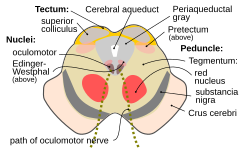The cerebral aqueduct (aqueduct of the midbrain, aqueduct of Sylvius, Sylvian aqueduct, mesencephalic duct) is a small, narrow tube connecting the third and fourth ventricles of the brain.[1][2] The cerebral aqueduct is a midline structure that passes through the midbrain. It extends rostrocaudally through the entirety of the more posterior part of the midbrain. It is surrounded by the periaqueductal gray (central gray), a layer of gray matter.[3]
| Cerebral aqueduct | |
|---|---|
 Section through superior colliculus showing path of oculomotor nerve. | |
 Drawing of a cast of the ventricular cavities, viewed from the side. | |
| Details | |
| Part of | Ventricular system |
| Identifiers | |
| Latin | aqueductus mesencephali (cerebri) aqueductus Sylvii |
| MeSH | D002535 |
| NeuroNames | 509 |
| NeuroLex ID | birnlex_1261 |
| TA98 | A14.1.06.501 |
| TA2 | 5910 |
| FMA | 78467 |
| Anatomical terms of neuroanatomy | |
Congenital stenosis of the cerebral aqueduct is a cause of congenital hydrocephalus.[3]
It is named for Franciscus Sylvius.
Anatomy
editThe cerebral aqueduct is roughly circular in transverse section, and measures 1-2 mm in diameter.[3] It is 15 mm long and is commonly subdivided into a pars anterior antrum, and pars posterior.[2]
Relations
editRostrally, it is continuous with the third ventricle, commencing just inferior to the posterior commissure.[3]
Caudally, it is continuous with the fourth ventricle at the junction of the mesencephalon and pons.[3]
The midbrain tegmentum is situated anteriorly to the cerebral aqueduct.[3] The portion of the tegmentum posterior to the aqueduct is the tectum.[1] The superior and inferior colliculi that make up the corpora quadrigemina are situated posteriorly to it.[3]
Development
editThe cerebral aqueduct, as other parts of the ventricular system of the brain, develops from the central canal of the neural tube, and it originates from the portion of the neural tube that is present in the developing mesencephalon, hence the name "mesencephalic duct."[4]
Function
editThis section needs expansion. You can help by adding to it. (January 2014) |
The cerebral aqueduct acts as a canal that passes through the midbrain. It connects the third ventricle with the fourth ventricle so that cerebrospinal fluid (CSF) moves between the cerebral ventricles and the canal connecting these ventricles.[5]
Clinical significance
editAqueductal stenosis, a narrowing of the cerebral aqueduct, obstructs the flow of CSF and has been associated with non-communicating hydrocephalus. Such narrowing can be congenital, arise via tumor compression (e.g. pinealoblastoma), or through cyclical gliosis secondary to an initial partial obstruction.[5]
History
editThe cerebral aqueduct was first named after Franciscus Sylvius.[6]
Additional images
edit-
Transverse section through mid-brain; number 2 indicates the cerebral aqueduct.
-
Transverse section of mid-brain at level of inferior colliculi.
-
Transverse section of mid-brain at level of superior colliculi.
-
MRI section of mid-brain.
-
Median sagittal section of brain.
-
Scheme showing relations of the ventricles to the surface of the brain.
-
Cerebral aqueduct
-
Cerebral aqueduct
-
Cerebral peduncle, optic chasm, cerebral aqueduct. Inferior view. Deep dissection.
-
Cerebral peduncle, optic chasm, cerebral aqueduct. Inferior view. Deep dissection.
-
Cerebrum. Inferior view. Deep dissection
See also
editReferences
edit- ^ a b Sinnatamby, Chummy S. (2011). Last's Anatomy (12th ed.). p. 476. ISBN 978-0-7295-3752-0.
- ^ a b Rubino, Jessica M.; Hogg, Jeffery P. (2024), "Neuroanatomy, Cerebral Aqueduct (Sylvian)", StatPearls, Treasure Island (FL): StatPearls Publishing, PMID 31082032, retrieved 2024-07-02
- ^ a b c d e f g Standring, Susan (2020). Gray's Anatomy: The Anatomical Basis of Clinical Practice (42th ed.). New York: Elsevier. p. 409. ISBN 978-0-7020-7707-4. OCLC 1201341621.
- ^ Le, Tao; Bhushan, Vikas; Vasan, Neil (2010). First Aid for the USMLE Step 1: 2010 20th Anniversary Edition. USA: The McGraw-Hill Companies, Inc. pp. 126. ISBN 978-0-07-163340-6.
- ^ a b Rubino, Jessica; Hogg, Jeffery (31 July 2020). Neuroanatomy, cerebral aqueduct (Sylvian). Treasure Island, FL: StatPearls Publishing.
- ^ Kompanje, Erwin J. O. (1 January 2005). "An historical homage from Denmark: the aqueduct of Sylvius". Neurosurgical Review. 28 (1): 77–78. doi:10.1007/s10143-004-0361-6. ISSN 1437-2320.
External links
edit- Atlas image: n2a3p2 at the University of Michigan Health System